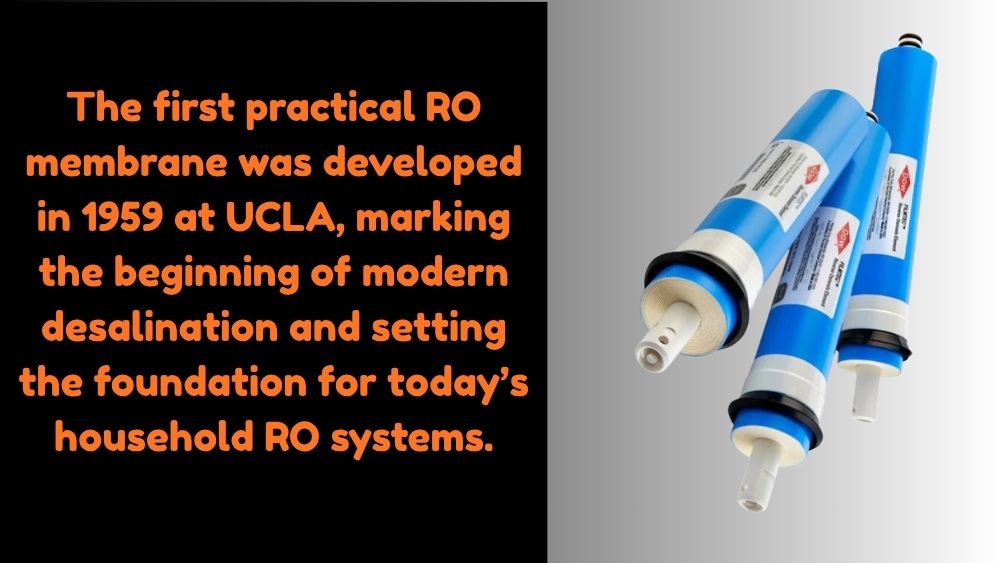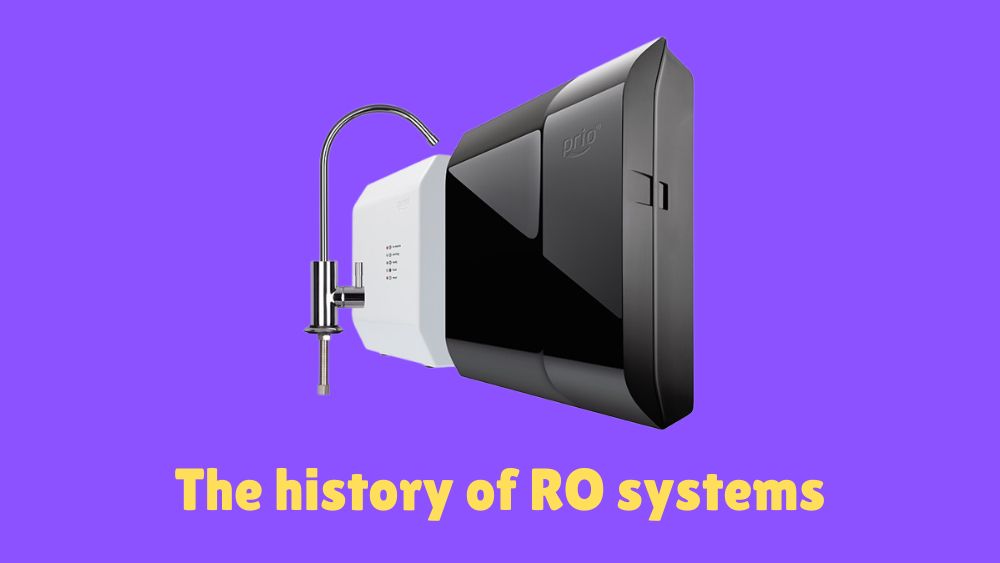Have you ever wondered how the water purifier you trust every day came to be? Understanding the history of the RO water purifier can give you a new appreciation for the clean water it provides.
From simple beginnings to advanced technology, the story behind RO water purifiers reveals how science and innovation joined forces to protect your health. Keep reading to discover how this amazing device evolved and why it matters to you and your family’s well-being.
Early Water Purification Methods
Water purification has been important for humans since ancient times. People needed clean water to stay healthy. Early methods used simple tools and natural materials. These methods helped remove dirt and some harmful substances. They laid the foundation for modern water purifiers like RO systems.
Ancient Filtration Techniques
Ancient civilizations used sand, charcoal, and cloth to filter water. They poured water through layers of sand to trap dirt. Charcoal helped remove bad smells and some impurities. Cloth acted as a basic filter to catch larger particles. These methods improved water clarity but did not remove all germs.
Traditional Boiling And Sedimentation
Boiling water was a common way to kill germs. People heated water until it bubbled to make it safer. Sedimentation involved letting dirty water stand still. Heavy particles settled at the bottom over time. Clear water was then poured off the top. These simple steps made water safer to drink but were not perfect.
Birth Of Reverse Osmosis Technology

Reverse osmosis (RO) technology began as a solution to clean water needs. It started with the study of natural osmosis, a process where water moves through a membrane. Scientists wanted to reverse this process to remove impurities from water.
This technology grew from curiosity and hard work. Researchers aimed to create a filter that could block salt and other harmful particles. Their goal was simple: provide safe drinking water for many people.
Scientific Principles Behind RO
RO works by pushing water through a special membrane. This membrane lets water pass but stops salts and dirt. The pressure forces pure water to move in the opposite direction of natural osmosis.
The membrane acts like a barrier. It blocks larger particles while allowing clean water molecules through. This process removes most contaminants from the water.
Initial Development And Challenges
The first RO membranes were not strong or efficient. Scientists faced problems with membrane durability and water flow. Early devices needed high pressure, making them expensive and hard to use.
Over time, improvements made RO more practical. New materials helped create better membranes. These changes lowered costs and increased water output.
Evolution Of RO Water Purifiers
The evolution of RO water purifiers shows how technology improved drinking water quality. It started with basic models and moved to advanced systems. Each step made water safer and more accessible.
Understanding the journey helps appreciate the current devices that many use daily. This history reveals the effort to provide clean water worldwide.
Early Commercial Models
The first RO water purifiers appeared in the 1960s. They were large and costly machines. Mainly, industries and hospitals used them. These models removed salt and impurities effectively but were not for home use.
Early models needed high pressure and lots of energy. Maintenance was difficult and expensive. Still, they proved reverse osmosis could clean water well.
Technological Advancements Over Time
In the 1980s, smaller and cheaper RO purifiers came out. Manufacturers improved membranes to block more contaminants. Energy use dropped, making devices more efficient.
Modern RO purifiers include multiple filters for better taste and safety. Some have smart features and easy maintenance. These changes made RO water purifiers popular for homes worldwide.
Impact On Public Health
The impact of RO water purifiers on public health has been significant. These devices remove harmful substances from water. This leads to safer drinking water for many people. Clean water reduces illness and boosts overall health.
Reduction In Waterborne Diseases
RO purifiers help cut down waterborne diseases. They filter out bacteria, viruses, and parasites. These pathogens cause illnesses like diarrhea and cholera. Using RO water lowers infection risks. This keeps families healthier and reduces doctor visits.
Access To Clean Drinking Water Worldwide
RO technology has expanded access to clean water. Many areas with poor water quality now benefit. Portable and affordable RO purifiers reach remote places. This access helps prevent disease outbreaks. Clean water improves life quality for millions globally.
Modern Innovations In RO Purifiers
Modern RO water purifiers have changed a lot from their early versions. New technology makes these purifiers smarter and more useful. They use less power and fit better in small homes. These improvements help more people get clean water easily.
Energy Efficiency Improvements
RO purifiers now use less electricity than before. Advanced motors and pumps reduce power use. This lowers electricity bills and saves energy. Many models have energy-saving modes. These modes turn off parts when not needed. This helps protect the environment too.
Smart And Compact Designs
Modern RO purifiers come in smaller sizes. They fit well in kitchens with limited space. Smart features include touch controls and digital displays. Some purifiers connect to phones for easy control. These designs make water purification simple and quick.
Future Trends In Water Purification
The future of water purification holds exciting possibilities. Technology and sustainability will shape how we clean water. Innovations aim to make water purifiers smarter and greener. These trends will improve water quality and reduce waste.
Integration With Iot And Ai
Water purifiers will connect to the internet for better control. IoT devices allow users to monitor water quality in real time. AI helps predict when filters need changing. This reduces maintenance and ensures clean water always. Smart systems can adjust purification based on water conditions. This makes purification more efficient and personalized.
Sustainable And Eco-friendly Solutions
Future water purifiers will focus on saving energy and reducing waste. New filters will last longer and use fewer chemicals. Some designs will recycle water to avoid waste. Materials used will be biodegradable or recyclable. These changes lower the impact on the environment. Cleaner water and a cleaner planet, together.
How RO System Reviews Can Help You with History of RO Water Purifier
Practical Learning from the History of RO Water Purifiers
Understanding the history of RO water purifiers offers valuable insights that go beyond technology itself. By exploring early water purification methods and the birth of reverse osmosis technology, one can appreciate the challenges that led to modern innovations. This perspective helps households make informed decisions when choosing or upgrading their water purification systems.
For those curious about how these advancements impact daily life, learning about the evolution of RO purifiers and their role in improving public health can provide a broader context. It highlights why certain features matter and how they contribute to safer drinking water.
- Researching the progression from basic filtration to advanced RO technology
- Understanding the benefits and limitations of different purification stages
- Staying updated on future trends for smarter water management
RO System Reviews, dedicated to helping households enjoy cleaner and better-tasting water, offers resources that can deepen your knowledge. For more detailed information or specific inquiries, reaching out via [email protected] can be a helpful step in your learning journey.
Frequently Asked Questions
What Is The Origin Of RO water Purifiers?
RO water purifiers originated in the 1960s for desalination purposes. Reverse Osmosis technology removes impurities by forcing water through a semipermeable membrane. Initially used in industries, it later became popular for household water purification due to its efficiency in removing contaminants.
How Does RO Water Purification Work?
RO purification works by pushing water through a thin membrane. This membrane blocks impurities, chemicals, and bacteria. Only pure water molecules pass through. It effectively removes dissolved salts, heavy metals, and harmful microorganisms, ensuring safe drinking water.
When Did RO Purifiers Become Popular For Homes?
RO purifiers gained popularity in homes during the 1990s. Rising water pollution and health awareness increased demand for clean drinking water. Advances in technology made RO systems affordable and accessible for everyday use, transforming household water purification.
Why Is RO Water Purifier History Important?
Understanding RO purifier history reveals its technological evolution. It shows how water purification improved over time. This knowledge helps consumers appreciate the innovation behind safe drinking water. It also highlights the growing need for clean water solutions globally.
Conclusion
RO water purifiers have changed how people access clean water. They remove harmful impurities and make water safe to drink. Over time, these devices have become more affordable and efficient. Many families now trust RO purifiers for daily use. Clean water means better health and peace of mind.
The history of RO purifiers shows human effort to improve life quality. Today, they remain an important tool for safe drinking water worldwide. Simple technology, big impact.

Hasan Al Sarker is a Reverse Osmosis Specialist. He has worked for many years to ensure safe drinking water for all. His research paper has been published in several journals, including Issue, Medium, and Slideshare. He is recognized as a water doctor among specialists though he did not attend medical college.
Besides working as a researcher of reverse osmosis technology, he is also very fancy with the kitchen and cooking. His guides are reading thousands of people every day. As a head of content, he is responsible for all the published articles at RO System Reviews.

